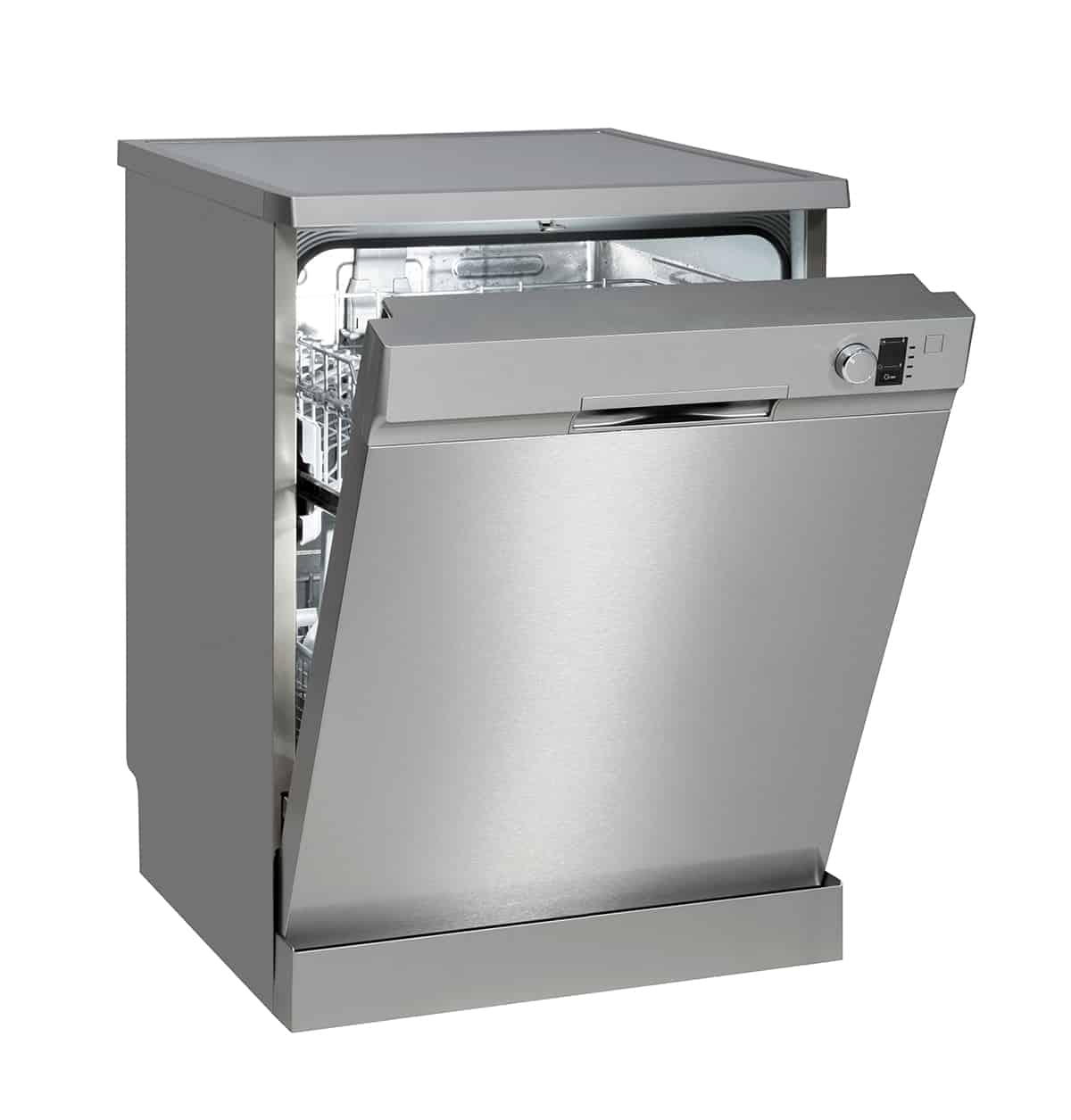So, you’ve finally decided to get a dishwasher and reduce how much water (and time) you spend on doing the dishes. Good for you! The only thing left to do is to decide whether to get a built-in or a freestanding dishwasher. Unfortunately, choosing between the two is a lot more complicated than it initially seems.
In this guide, I’ll talk explain what a built-in dishwasher is and how it compares to freestanding dishwashers, as well as provide a side-by-side comparison between the two types of dishwashers based on various features and specs.
What Is a Built-in Dishwasher?

A built-in dishwasher is exactly what its name suggests—it’s a dishwasher that is fixed into place. Most built-in dishwashers are installed beneath countertops or installed between cabinets. This is, by far, the more popular type of dishwasher.
There are two types of built-in dishwashers to consider—semi-integrated and fully integrated.
Semi-integrated dishwashers still have a portion of their door panel exposed. While it can be mounted beside cabinets or underneath a countertop, the door usually pops out by about an inch, so it’s not completely flush with the adjacent cabinets.
Fully integrated dishwashers are permanently built into your kitchen fixtures. Their doors are usually flush with the doors of adjacent cabinets, so there’s no risk of accidentally bumping into the door when walking past the machine.
Built-in dishwashers aren’t just permanently set in place by their mounting brackets. They are also usually hardwired to your home’s electrical system, so there’s very little wiggle room for them to move in and out of place. However, because they aren’t designed to move around, they integrate extremely well with their surroundings.
What Is a Freestanding Dishwasher?
A freestanding dishwasher is much like a stove-oven unit in that it is not fixed to anything. It can be installed anywhere in your kitchen as long as you can connect it to a water inlet line and a wall outlet.
You can find freestanding dishwashers in 2 distinct sizes—full-size and countertop.
A full-size freestanding dishwasher looks and operates much like a built-in dishwasher, except that you can move it around since it’s not fixed onto anything. A countertop dishwasher is one that sits atop your kitchen counter. It’s much smaller in size, so it doesn’t generate as much noise. However, it doesn’t wash nearly as many place settings per cycle as a full-size unit.
Built-in vs. Freestanding Dishwasher: A Head-to-Head Comparison
Now that we understand the basics of built-in and freestanding dishwashers, let’s take a look at how they compare in terms of specs and features.
Available features
When it comes to features, you will usually find a wider range of them in built-in dishwashers than you will in their freestanding counterparts. Such features include multiple spray arms and highly specialized wash programs.
That’s not to say freestanding dishwashers don’t come with their fair share of features—in fact, if you’re looking for a barebones basic dishwasher, a freestanding model fits the bill the best.
Size
One of the clearest distinguishing features between built-in and freestanding dishwashers is their size. Built-in dishwashers are usually around 24 inches wide and can wash up to 14 place settings per cycle.
Don’t have many guests over for dinner that often? Then you should probably think about getting a freestanding dishwasher instead. These machines are usually around 18 inches wide and can wash eight place settings at a time. Freestanding dishwashers are great for homes or apartments without much space.
Convenience
Built-in dishwashers can be a double-edged sword in terms of convenience. First, they are extremely convenient because they don’t get in the way (remember how they can sit flush with your cabinets?). Also, because they’re always in place, you don’t have to worry about the water inlet line becoming undone. Built-in dishwashers don’t move, so there’s no risk that the water line will get nudged out of position.
The downside is that built-in dishwashers are usually the first thing to be left behind when you move homes. You can uninstall them, but it can take quite a bit of time and effort to do.
Freestanding dishwashers are convenient in how you can transport them from place to place, even within the confines of your kitchen. They’re also a bit smaller, so finding a spot in your kitchen shouldn’t be too much trouble.
The downside is that freestanding dishwashers because they’re movable, can be knocked out of place. This means a greater risk of the water and drain lines, as well as its power cord, becoming undone.
Installation

Wherever you want to install a built-in dishwasher, that’s where it’s going to remain until the end of its life. That means you will have to find a spot in your kitchen that isn’t just close to the garbage disposal and a water inlet line, but you may have to hire a plumber and an electrician to ensure that all of the water and electrical works are securely in place.
The same can be said for freestanding dishwashers but to a lesser extent. While the dishwasher’s position has to be at the right distance from your sink and the garbage disposal, it’s a lot more forgiving since you can move it from place to place.
Upfront Cost
Although prices fluctuate, built-in dishwashers are generally more expensive than freestanding dishwashers. So, not only do you have to worry about heightened installation costs, but you also have to think about spending a bit more upfront to take a built-in dishwasher home with you.
Is it worth the cost? Yes, it is. A built-in dishwasher can actually increase the value of your home! If your goal is to increase your home’s value while spending as little as possible, a built-in dishwasher can be the perfect investment for your kitchen.
Performance
This is one aspect where the type of dishwasher shouldn’t convince you to choose one or the other. Dishwasher performance is heavily affected by the brand, not the type. In short, built-in dishwashers are just as effective as freestanding dishwashers, and vice versa.
Noise Output
There’s no way around it—dishwashers are loud. However, an under-the-counter dishwasher with a front door can be somewhat beneficial in blocking some of the noise. As long as it can be concealed behind cabinetry, it shouldn’t be hard to hear yourself think.
Freestanding dishwashers, however, do not fit behind cabinetry. The only soundproofing system it relies on is the metal shell, and that doesn’t do much to reduce noise levels. So, if you don’t want to hear the whirring and droning of your dishwasher during the middle of the day, either run it at nighttime or get an under-the-counter dishwasher for your kitchen.
Hardwired
The type of dishwasher will not determine whether or not it’s hardwired. After all, most modern dishwashers do not come with a plug, so you have the option of hardwiring it to your home’s electrical system as soon as you remove it from the box.
That said, built-in dishwashers are usually hardwired, whereas freestanding units have a plug and cord. Keeping the wires out of the way is a great way to ensure nothing happens to the cable, especially when you can’t remove your dishwasher whenever you want.
Also, hardwiring a freestanding dishwasher pretty much defeats its purpose. You’re supposed to be able to move it around, and hardwiring it pretty much cements it into place.
So, Should You Get a Built-in Dishwasher or a Freestanding Dishwasher?
When in doubt, let your wallet do the thinking for you. Freestanding dishwashers are smaller and cheaper and cost less to install. Built-in modes are bulkier and cost way more to set up. However, for the added cost, you also get added convenience and possibly an increase in your home’s value!






